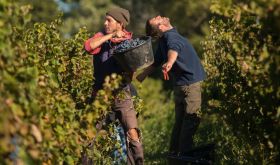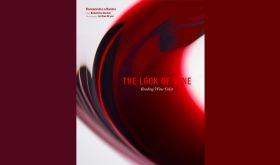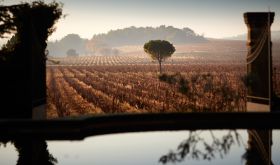This was first published on 26 February on Purple Pages but we are re-publishing it today as part of our new Throwback Thursday habit since the evolution of California wine is currently so much discussed online
There's something about pontificating far from home that loosens the tongue. It certainly happens to me, and it was notable that when Christian Moueix of Bordeaux presented a range of his Napa Valley wines Dominus at Corkbuzz in New York last October (see Moueix's dire predictions on Bordeaux 2013 published on Monday), he was delightfully forthright, more so it seemed to me than when in his office in Libourne. He touched on the failings of his Napa neighbours, the brett in his wines, 'crazy' alcohol levels, wines that taste of prunes, the virus threat, reverse osmosis and the foolishness of hillside planting. I even have the following quote written down, which is a mite inflammatory: 'excessive temperatures in Napa Valley make it a challenge for the wines to belong on a world class level'.
We began with a brief history of the much-discussed Dominus ('is it irredeemably French?' is one angle; another at one time was criticism of the series of portraits of Moueix himself on the original labels). The first vintage was 1983, made at the Rombauer winery with fruit from the Napanook vineyard as part of a joint venture with the daughters of John Daniel, the old owner of Inglenook. When the time came, in 1997, to build their own winery on the vineyard just north of Yountville on the west side of Napa Valley, construction decisions 'brought some tension because of a difference of taste', as he put it, so he bought them out in January 2005.
Christian and his very artistically aware second wife Cherise chose the world-famous, cutting edge Swiss architects Herzog and de Meuron. 'Now I'm surprised I took such a risk', Moueix told us, about the extraordinary box-like building that has what are effectively rocks inside chicken wire instead of walls, 'but in the end I am pleased by how well it is integrated into the landscape – and it's very functional.' We chose it as our illustrative winery in the fifth edition of The World Atlas of Wine.
He said that in 1994 and 2001 he knew straightaway that these were great vintages, adding, 'I'm hoping to have the same emotion about 2013'. He admitted that his 1994 'has a bit of brett, which makes it more interesting but more difficult to appreciate. [Celebrated northern California winemaker] Dave Ramey says most burgundy has brett and that it adds to the complexity. I don't aim to make bordeaux in Napa but you can bring a bit of culture, in both senses. I try not to pick too late. Overripeness is the single most undesirable thing in Napa. When I arrived I said two things:
'Firstly I was determined to have dry farming (apart from the very young vines). This is not insignificant in the Napa climate which often has 100 ºF days. There can be no rain at all from early May to late October.' [And even less in 2013 – see Alder's recent report – JR]. 'Thanks to our ability to measure humidity, we now know exactly when we risk sunburn. If humidity falls below 50%, then it's dangerous, so we're experimenting with misting systems. Dry farming encourages deep roots and is key for expressing terroir. I have not had the success I had hoped for to convince my friends to give up irrigation, They say the vines will die. No, they come from the Caucasus and can withstand anything. Write about dry farming please. Unirrigated vines will naturally find their equilibrium and won't need to be picked as late as irrigated vines. People accuse us of avoiding risks by picking early but it's a question of natural equilibrium. Irrigation is one of the reasons you get these crazy alcohol levels in Napa. I'm obsessed by dry farming even 30 years after arriving in Napa Valley.
'The second thing I was determined not to do was acidification. I have never acidified a single vat in 30 years. Of course if you get overripe fruit you need to acidify with tartaric acid, but it combines with tannins to make the wine taste very hard.
'In Napa Valley you hear a lot about ecology and an organic approach. But even though we don't have enough water, I see people irrigating within hours of picking. There is something wrong here.'
I think he must have realised he was sounding off a bit because he then added, 'I mean this not as a criticism but a helpful observation. There are some parts of Napa, especially on top of the hills, where I don't know the terrain. Perhaps they do need irrigation there.
'We never look for a fruit bomb. I hate the idea of a fruit bomb. Remember, before vines arrived in the Napa Valley there were prunes. The dominant flavour in Napa wines today is prune – it's natural. It's not an unpleasant taste but it's extreme. Black fruits is the end. It is never my goal to make wines that taste like prunes. The main problem in Napa is virus – it's the same all over the world. Why? Because people are stupid. You have the same culture in the same place for too long, The soils are saturated by microbes, etc. You should really let the soil lie fallow every six or seven years. Or you plough and (illegally) disinfect.
'Reverse osmosis has changed winemaking around the world. I hate it and have never used it. It provides a quick fix for any mistake you have made and provides an artificial equilibrium. It's unnatural – like plastic surgery for correcting faults which shouldn't have occurred. My objection is philosophical. The tendency in Bordeaux is gravity-fed wineries. The idea is that the clusters should arrive in a virginal state but, for instance, at Quintessa they take gravity to such an extreme that they ignore the beautiful Italian peristatic pumps which treat grapes and musts so delicately.'
He admitted that he had made mistakes. 'Thirty years ago one vat turned to vinegar. There is not a producer in Bordeaux who has not lost one vat, maybe one whole vintage, to volatile acidity.
'There is an interesting correlation between the amount of winter rain and the (reduced) quality of the subsequent vintage in Napa Valley. We have very few disasters in Napa. Okay, 2011 was too rainy and occasionally too hot. But overall the climate is much easier than Bordeaux's. In Napa the current obsession is with elevation and hillside sites. (We see millionaire's buildings there which are usually ugly.) I think hillside vineyards are a big mistake. They need irrigation and anyway it's not a natural habitat for vines. We will see what they become in a century. For me there is a danger at those altitudes.
'We are described as valley floor but the real valley floor is just the flat bit by the river that is flooded occasionally. We're actually on a slope that has natural drainage. Dominus is on the volcanic foothills of the Mayacamas (they call it gravelly locally but for me it's not gravelly at all).'
Another distinguishing feature of Christian Moueix is his refusal to play any sort of varietal game. In a valley whose press kits are littered with grape percentages, he says defiantly, 'we produce a wine whose assemblage will never be divulged even under torture – what does it matter?'
He will admit to having a problem with Cabernet Franc: 'It's difficult to get it to perfect ripeness. The clones are very questionable. It gets ripe only every other year.'
He wanted to discuss over-extraction too: 'After fermentation how do you decide when to separate the must from the skins? You taste daily and if you're serious, when you start to taste marc then you drain the must. But some people go for 15, 20 days or more so they go from red to black fruits. Today there are far too many wines that are overripe and over-extracted.
'In 2013 we finished picking on 26 September in Napa. He told how someone described as 'a friend' on the plane from France to New York the day before, 23 October, had told him that his California clients had just finished picking in Napa. Michel Rolland perhaps?
I have had the pleasure of tasting Dominus regularly almost from its inception. (I remember keeping the first two winemakers waiting a shamefully long time as I drove back to the Rombauer winery from the Sierra Foothills.) It does seem to be going from strength to strength, though is always highly distinctive.
There's something about pontificating far from home that loosens the tongue. It certainly happens to me, and it was notable that when Christian Moueix of Bordeaux presented a range of his Napa Valley wines Dominus at Corkbuzz in New York last October (see Moueix's dire predictions on Bordeaux 2013 published on Monday), he was delightfully forthright, more so it seemed to me than when in his office in Libourne. He touched on the failings of his Napa neighbours, the brett in his wines, 'crazy' alcohol levels, wines that taste of prunes, the virus threat, reverse osmosis and the foolishness of hillside planting. I even have the following quote written down, which is a mite inflammatory: 'excessive temperatures in Napa Valley make it a challenge for the wines to belong on a world class level'.
We began with a brief history of the much-discussed Dominus ('is it irredeemably French?' is one angle; another at one time was criticism of the series of portraits of Moueix himself on the original labels). The first vintage was 1983, made at the Rombauer winery with fruit from the Napanook vineyard as part of a joint venture with the daughters of John Daniel, the old owner of Inglenook. When the time came, in 1997, to build their own winery on the vineyard just north of Yountville on the west side of Napa Valley, construction decisions 'brought some tension because of a difference of taste', as he put it, so he bought them out in January 2005.
Christian and his very artistically aware second wife Cherise chose the world-famous, cutting edge Swiss architects Herzog and de Meuron. 'Now I'm surprised I took such a risk', Moueix told us, about the extraordinary box-like building that has what are effectively rocks inside chicken wire instead of walls, 'but in the end I am pleased by how well it is integrated into the landscape – and it's very functional.' We chose it as our illustrative winery in the fifth edition of The World Atlas of Wine.
He said that in 1994 and 2001 he knew straightaway that these were great vintages, adding, 'I'm hoping to have the same emotion about 2013'. He admitted that his 1994 'has a bit of brett, which makes it more interesting but more difficult to appreciate. [Celebrated northern California winemaker] Dave Ramey says most burgundy has brett and that it adds to the complexity. I don't aim to make bordeaux in Napa but you can bring a bit of culture, in both senses. I try not to pick too late. Overripeness is the single most undesirable thing in Napa. When I arrived I said two things:
'Firstly I was determined to have dry farming (apart from the very young vines). This is not insignificant in the Napa climate which often has 100 ºF days. There can be no rain at all from early May to late October.' [And even less in 2013 – see Alder's recent report – JR]. 'Thanks to our ability to measure humidity, we now know exactly when we risk sunburn. If humidity falls below 50%, then it's dangerous, so we're experimenting with misting systems. Dry farming encourages deep roots and is key for expressing terroir. I have not had the success I had hoped for to convince my friends to give up irrigation, They say the vines will die. No, they come from the Caucasus and can withstand anything. Write about dry farming please. Unirrigated vines will naturally find their equilibrium and won't need to be picked as late as irrigated vines. People accuse us of avoiding risks by picking early but it's a question of natural equilibrium. Irrigation is one of the reasons you get these crazy alcohol levels in Napa. I'm obsessed by dry farming even 30 years after arriving in Napa Valley.
'The second thing I was determined not to do was acidification. I have never acidified a single vat in 30 years. Of course if you get overripe fruit you need to acidify with tartaric acid, but it combines with tannins to make the wine taste very hard.
'In Napa Valley you hear a lot about ecology and an organic approach. But even though we don't have enough water, I see people irrigating within hours of picking. There is something wrong here.'
I think he must have realised he was sounding off a bit because he then added, 'I mean this not as a criticism but a helpful observation. There are some parts of Napa, especially on top of the hills, where I don't know the terrain. Perhaps they do need irrigation there.
'We never look for a fruit bomb. I hate the idea of a fruit bomb. Remember, before vines arrived in the Napa Valley there were prunes. The dominant flavour in Napa wines today is prune – it's natural. It's not an unpleasant taste but it's extreme. Black fruits is the end. It is never my goal to make wines that taste like prunes. The main problem in Napa is virus – it's the same all over the world. Why? Because people are stupid. You have the same culture in the same place for too long, The soils are saturated by microbes, etc. You should really let the soil lie fallow every six or seven years. Or you plough and (illegally) disinfect.
'Reverse osmosis has changed winemaking around the world. I hate it and have never used it. It provides a quick fix for any mistake you have made and provides an artificial equilibrium. It's unnatural – like plastic surgery for correcting faults which shouldn't have occurred. My objection is philosophical. The tendency in Bordeaux is gravity-fed wineries. The idea is that the clusters should arrive in a virginal state but, for instance, at Quintessa they take gravity to such an extreme that they ignore the beautiful Italian peristatic pumps which treat grapes and musts so delicately.'
He admitted that he had made mistakes. 'Thirty years ago one vat turned to vinegar. There is not a producer in Bordeaux who has not lost one vat, maybe one whole vintage, to volatile acidity.
'There is an interesting correlation between the amount of winter rain and the (reduced) quality of the subsequent vintage in Napa Valley. We have very few disasters in Napa. Okay, 2011 was too rainy and occasionally too hot. But overall the climate is much easier than Bordeaux's. In Napa the current obsession is with elevation and hillside sites. (We see millionaire's buildings there which are usually ugly.) I think hillside vineyards are a big mistake. They need irrigation and anyway it's not a natural habitat for vines. We will see what they become in a century. For me there is a danger at those altitudes.
'We are described as valley floor but the real valley floor is just the flat bit by the river that is flooded occasionally. We're actually on a slope that has natural drainage. Dominus is on the volcanic foothills of the Mayacamas (they call it gravelly locally but for me it's not gravelly at all).'
Another distinguishing feature of Christian Moueix is his refusal to play any sort of varietal game. In a valley whose press kits are littered with grape percentages, he says defiantly, 'we produce a wine whose assemblage will never be divulged even under torture – what does it matter?'
He will admit to having a problem with Cabernet Franc: 'It's difficult to get it to perfect ripeness. The clones are very questionable. It gets ripe only every other year.'
He wanted to discuss over-extraction too: 'After fermentation how do you decide when to separate the must from the skins? You taste daily and if you're serious, when you start to taste marc then you drain the must. But some people go for 15, 20 days or more so they go from red to black fruits. Today there are far too many wines that are overripe and over-extracted.
'In 2013 we finished picking on 26 September in Napa. He told how someone described as 'a friend' on the plane from France to New York the day before, 23 October, had told him that his California clients had just finished picking in Napa. Michel Rolland perhaps?
I have had the pleasure of tasting Dominus regularly almost from its inception. (I remember keeping the first two winemakers waiting a shamefully long time as I drove back to the Rombauer winery from the Sierra Foothills.) It does seem to be going from strength to strength, though is always highly distinctive.














